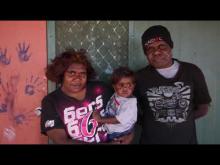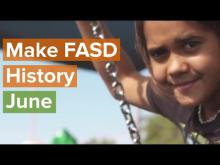A platform for success
"Early childhood education not only works to create a strong and stable foundation in formal education for young Aboriginal and Torres Strait children, but also provides an opportunity for those children to grow in, and share their sense of pride in their connection to culture, language, community and country." - Biripi early childhood teacher, Adam Duncan
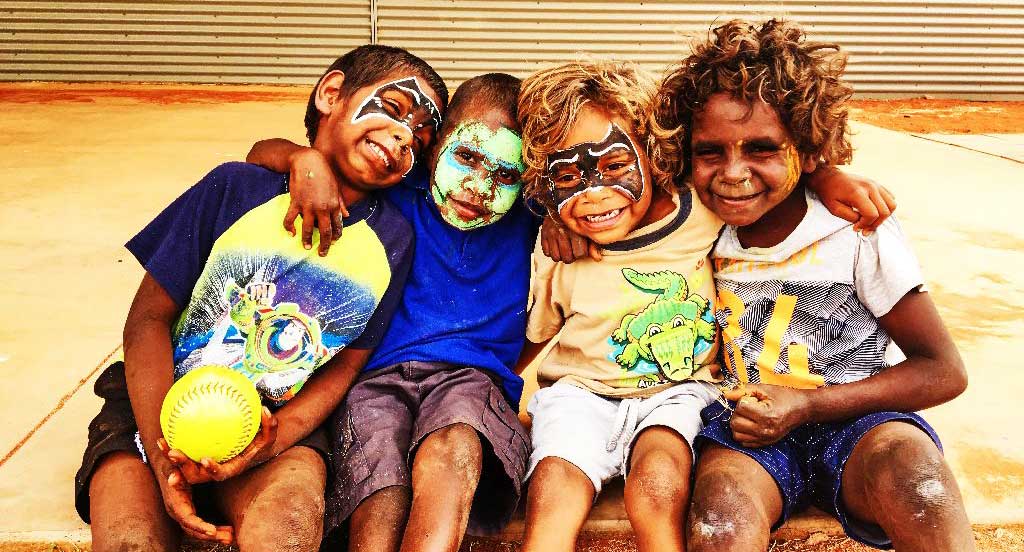
From left: Levi Williams, Tinam Burke, James Cooke and Emrick Stewart from Wiluna Remote Community School.
A good start in life
A healthy and safe start to life gives our children the greatest chance of succeeding at school and going on to make the most of their opportunities later in life.
Investing in children’s early years builds on the strengths of culture and care, and sets the course for a future of prosperity and opportunity. It supports strong foundations and underpins better health and social outcomes across the life course by:
- focusing on parents and families before, during, and after pregnancy; and
- embedding respect for Aboriginal and Torres Strait Islander cultures and languages in early learning settings.
Child mortality Target
Halve the gap in mortality rates for Indigenous children
under five within a decade (by 2018)
- The 2016 Indigenous child mortality rate is on track to halve the gap by 2018.
- Over the long term (1998-2016) the Indigenous child mortality rate has declined significantly and the gap has narrowed. However, progress has slowed since the 2008 target baseline.
- Improvements in recent years in Indigenous child and maternal health outcomes indicate further potential reductions in child mortality rates in coming years.
What the data tells us
National
The 2016 Indigenous child (0-4 year-old) mortality rate was within the range to meet the target by 2018 and is therefore on track (Figure 1). Progress against this target is measured using the ABS mortality data for 0-4 year-olds.[3]
In last year’s Closing the Gap report, a sudden increase in Indigenous child deaths in 2015 (mainly due to improvement in data collection methodology in Queensland) was noted.[4] The 2016 Indigenous child mortality rate has returned to being within the range required to meet the target.
Over the period 1998 to 2016, the Indigenous child mortality rate declined from 217 deaths per 100,000 to 146 deaths per 100,000, a reduction of around 35 per cent. There was also a significant narrowing of the child mortality gap, by 32 per cent.
More recently, from 2008, progress has slowed, with a decline in Indigenous child mortality rates by 11.5 per cent. Volatility in Indigenous child mortality rates in recent years has contributed to uncertainty around this shorter‑term estimate.[5] Over this period, the non-Indigenous child mortality rate has declined by 33 per cent, so the gap has not changed significantly.
Figure 1: Child mortality rates*
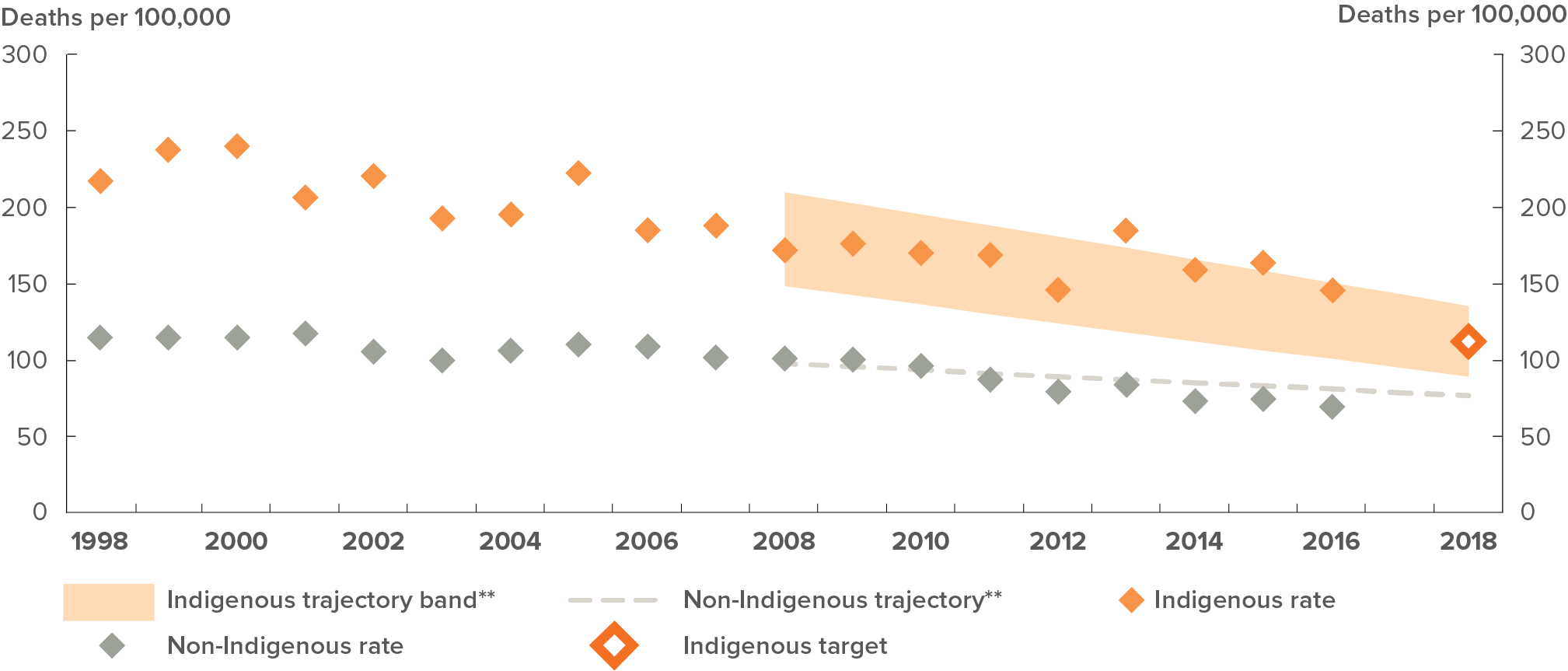
* Child mortality rates for New South Wales, Queensland, Western Australia, South Australia and the Northern Territory only.
** The non-Indigenous trajectory is based on the non-Indigenous trend between 1998 and 2012, from which the Indigenous trajectory was derived.
Sources: ABS and AIHW analysis of National Mortality Database
View the text alternative for Figure 1.
Over the period 2012 to 2016,[6] around 82 per cent of Indigenous child deaths (0-4 year-olds) were infant deaths (less than one year old). The Indigenous infant mortality rate was about double (1.9 times) the non-Indigenous rate over the period 2012 to 2016. More than half of deaths (53 per cent) in this group were caused by ‘perinatal conditions’ (such as, birth trauma, foetal growth disorders, complications of pregnancy, and respiratory and cardiovascular disorders).[7]
Between 1998 and 2016, the Indigenous infant mortality rate declined significantly by around 66.7 per cent (from 13.5 deaths per 1,000 live births in 1998 to 6 in 2016), and the gap has narrowed by 84.5 per cent. There has been a decline in Indigenous infant mortality rates by about 10 per cent (not statistically significant) from 2008.
Early childhood (1-4 year-olds) deaths account for the remaining 18 per cent of child deaths. Over the period 1998 to 2016, there has been a high degree of fluctuation in the early childhood mortality rate. The rate has declined by 21.6 per cent (not statistically significant) over this period.
The single largest cause of Indigenous child (0-4 year-old) mortality was perinatal conditions, which accounted for 43.5 per cent of Indigenous child deaths over the period 2012 to 2016. This cause also accounted for 42.7 per cent of the gap between Indigenous and non-Indigenous child mortality. Other important causes of child mortality were ‘sudden and ill-defined conditions’ (such as Sudden Infant Death Syndrome) causing 17.9 per cent of child deaths, and ‘congenital malformation’ (12.2 per cent) and ‘injury and poisoning’ (12 per cent of 0-4 year-old deaths).
Some health interventions can have a long lead time before measurable impacts are seen. The implementation timeframe for the Indigenous Early Childhood Development National Partnership Agreement provided for a lag of more than a decade before outcomes are expected to be seen (Australian Institute of Health and Welfare 2014).
While the full effect of the COAG initiatives on Indigenous child mortality rates may still take some time to become evident, a number of intermediate measures show that improvements in Indigenous child and maternal health have started to appear. For example, increases in the take up of antenatal care programs, reductions in the rate of maternal smoking during pregnancy and low birthweight babies (Box1: Improvements in maternal and child health risk factors) and increases in immunisation rates (Box 2: Immunisation). These emerging trends are expected to result in further reductions in child mortality rates.
It is important to build on these positive drivers of change through continued focus on child and maternal health care to ensure Indigenous children have a healthy start to life.
States and territories
Indigenous child mortality rates vary across jurisdictions (Figure 2). Over the period 2012 to 2016, New South Wales had the lowest Indigenous child mortality rate (110 per 100,000 population) and the smallest gap with non-Indigenous children (at 35 per 100,000). The Northern Territory had the highest Indigenous child mortality rate (332 per 100,000) and the largest gap (245 per 100,000).
Figure 2: Child (0-4 years) mortality rates by jurisdiction, 2012-2016
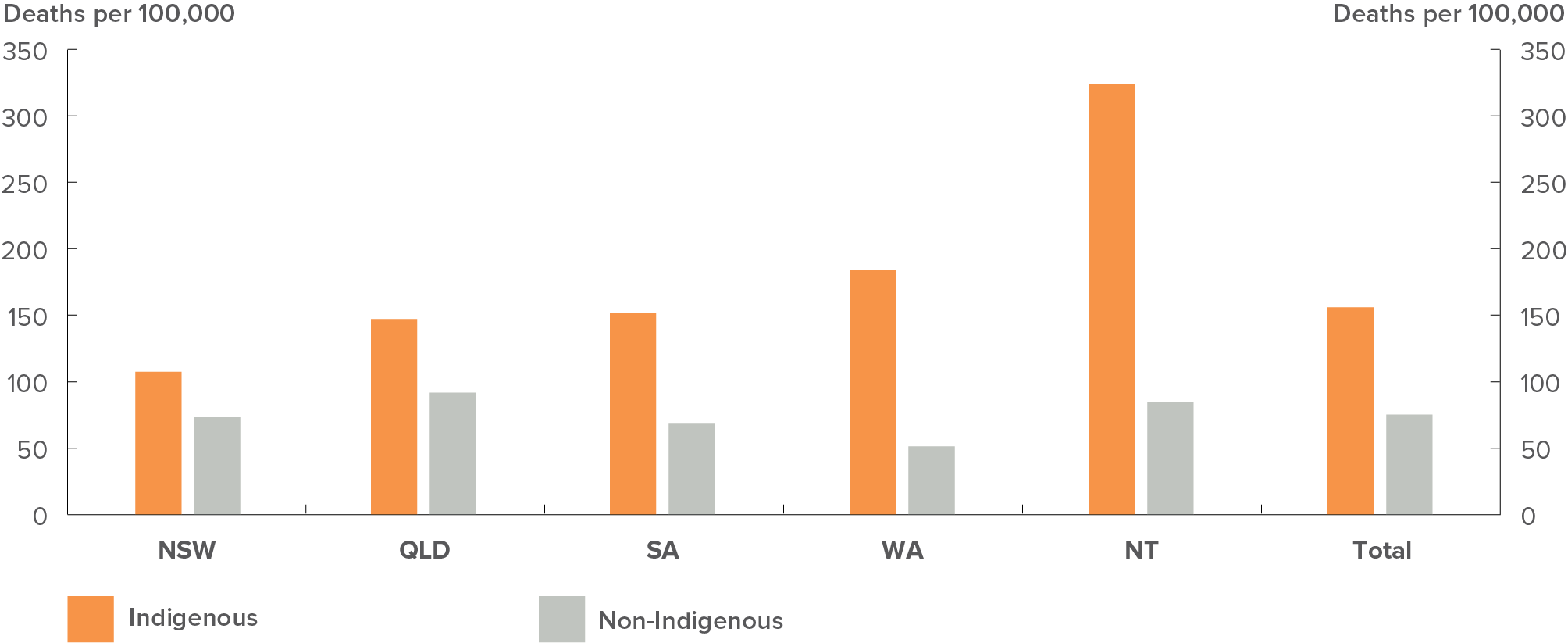
Sources: ABS and AIHW analysis of National Mortality Database
View the text alternative for Figure 2.
There have been positive developments and Indigenous child mortality rates have fallen in all of the five jurisdictions over the period 1998 to 2016. However, there are still gaps that would need to be addressed to ensure achievement of the target of halving the child mortality gap by 2018.
Smoking during pregnancy, poor antenatal care and low birthweight are among the key risk factors for pregnancy-related complications and adverse birth outcomes. In recent years, there have been some signs of improvement in these key maternal and child health risk factors.
The proportion of Indigenous mothers having an antenatal visit in the first trimester increased substantially between 2010 and 2015 (from 41 per cent to 57 per cent), getting close to the proportion of non-Indigenous mothers which has increased slightly (61 per cent to 63 per cent) over the same period.[8] In 2015, the proportion of Indigenous mothers receiving antenatal care in the first trimester was highest in Outer Regional areas with 63 per cent, compared with 58 per cent in Very Remote areas and 52 per cent in Major Cities (Australian Institute of Health and Welfare 2017a).
The proportion of Indigenous mothers having five or more antenatal visits has also increased slightly from 85 per cent in 2011 to 88 per cent in 2015.[9] Greater access to antenatal care means improving chances of having a healthy baby by providing Indigenous mothers with opportunities to find and treat any prenatal conditions and health risks early in pregnancy.
Smoking during pregnancy is one of the strongest risk factors contributing to the high rates of low birthweight among babies born to Indigenous mothers – up to 51 per cent of low birthweight births to Indigenous mothers have been attributed to smoking during pregnancy (Australian Health Ministers’ Advisory Council 2017). There has been a significant reduction in the proportion of Indigenous mothers who smoked during pregnancy from 50 per cent in 2009 to 45 per cent in 2015 (Figure 3).[10]
The proportion of low birthweight singleton babies born to Indigenous mothers has also fallen from 12 per cent in 2005 to 10.4 per cent in 2015. The proportion of low birthweight babies with non-Indigenous mothers remained between 4.6 and 4.8 per cent over this time, meaning the Indigenous rate is about twice the rate for babies born to non-Indigenous mothers (Australian Institute of Health and Welfare 2017a).
Figure 3: Indigenous maternal smoking and low child birthweight rates
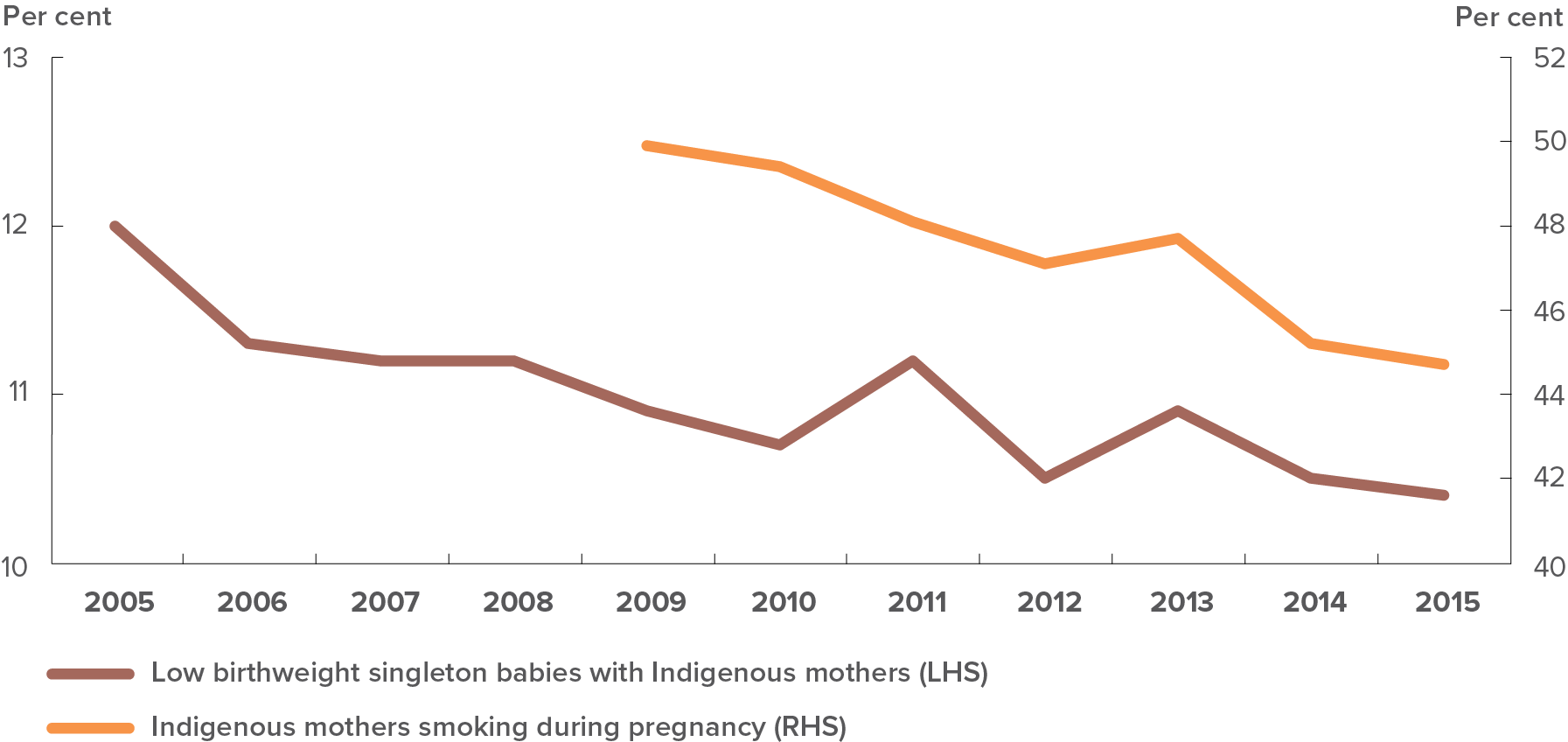
Source: AIHW, 2017
View the text alternative for Figure 3.
Immunisation is highly effective in reducing morbidity and mortality caused by vaccine-preventable diseases. Since the introduction of childhood vaccinations, deaths from vaccine-preventable diseases have fallen for the general population by 99 per cent.
Vaccinations are estimated to have saved some 78,000 lives and have been effective in reducing the disease disparities between Indigenous and non-Indigenous populations.
The Commonwealth Chief Medical Officer and state and territory Chief Health Officers have agreed on an aspirational target of 95 per cent immunisation coverage rate for all children. Over the past 10 years Australia has continued to improve immunisation rates in all children, but most notably for Aboriginal and Torres Strait Islander children aged five, which are the first cohort nationally to reach the 95 per cent aspirational target (Figure 4).
Figure 4: Share of children fully immunised
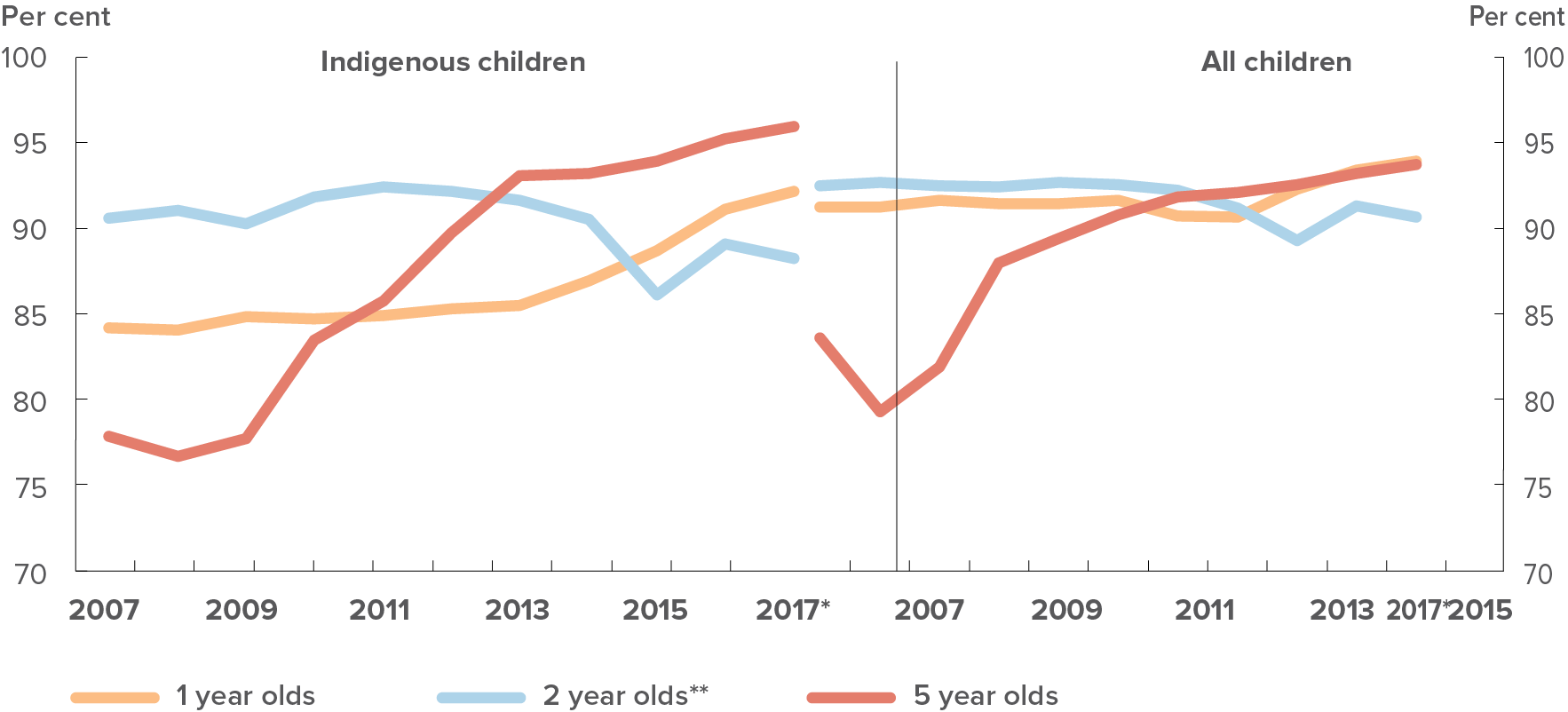
* 2017 data is for the nine months to September 2017
** There was a decline in coverage rates in December 2014 and March 2017 due to changes to the definition of full immunisation. The more antigens included in the assessment, the higher the likelihood of reduced coverage rates. This usually resolves over time as the changes become more routine.
Source: Australian Department of Health
View the text alternative for Figure 4.
Translating policy into action
Interventions within the first three years of life have shown to have the greatest impact on health and life outcomes. The Australian Government has a number of programs that prioritise investment in child and maternal health.
For example, funding of $94 million is being invested over three years from July 2015 for the Better Start to Life approach. This will expand two existing programs – the Australian Nurse Family Partnership Programme and the New Directions: Mothers and Babies Services Programme.
The Indigenous Advancement Strategy (IAS) funds a range of early childhood initiatives to support young mothers, parents and families including facilitated playgroups, parenting classes, home visiting and outreach programs. These activities build the knowledge and skills of Indigenous parents and promote the healthy development of children.
New Directions: Mothers and Babies Service
New Directions: Mothers and Babies Service (NDMBS) has expanded from 85 to 124 sites, with a further expansion planned for an additional 12 sites, bringing the total to 136. NDMBS continues to support Aboriginal and Torres Strait Islander children and their mothers with access to antenatal and postnatal care; standard information about baby care; practical advice and assistance with breast-feeding, nutrition and parenting; monitoring of developmental milestones, immunisation and infections; and health checks and referrals to treatment for Indigenous children before starting school.
Early childhood education Target
95 per cent of all Indigenous four-year-olds
enrolled in early childhood education (by 2025)
- The target to have 95 per cent of Indigenous four-year-olds enrolled in early childhood education is on track, with 91 per cent enrolment in 2016.
- All jurisdictions with the exception of the Northern Territory are on track. Five jurisdictions achieved enrolments of Indigenous children above the benchmark rate of 95 per cent in 2016.
- Of the Indigenous children enrolled in early childhood education, 93 per cent attended at least one hour in the reference week.
- More work needs to be done to improve attendance rates for Indigenous children to ensure they receive the full benefits from participation in early childhood education programs.
From conception to the first year of school, a child’s cognitive, physical, social and emotional development is in a stage of rapid growth – more than any other time in life. Our first years can shape other outcomes through life. They can influence our health, wellbeing, education, and employment. Learning and play during the years before school are critical to improving cognitive development. Accessing education during this time can also reduce the impact of barriers caused by disadvantage and poverty.
A supportive home environment is equally important for a child’s development, and this starts with the carers in the child’s life: parents, grandparents, and kin. Families and communities want their children to grow up in a safe, healthy and nurturing environment surrounded by their culture and community. For generations, tradition and dreaming have built tremendous strength, resilience, and pride.
Like any child, Aboriginal and Torres Strait Islander children should have the ability and opportunity to participate in preschool education. It provides an encouraging environment for a child to further develop and grow, and reach school ready and excited to learn (Box 1: Evidence from literature). Additionally, they bring great social, cultural and emotional strengths with them to their learning journey.
The current target on preschool enrolment ensures that Indigenous children across the nation have an equal chance of participating in education and setting their path to success.
Research shows quality early childhood education (ECE) is particularly important for vulnerable Indigenous children and can have a positive impact on school attendance and academic success. A recent study noted that Indigenous children who had attended ECE services were better equipped with social and developmental skills, which aided their transition into school (Social Research Centre 2016).
Several studies of the Australian Early Development Census (AEDC) data have shown that children who attend ECE are more likely to be developmentally on track at school entry (Jorgensen et al. 2017; Biddle & Bath 2013).
Analysis of data from the Longitudinal Study for Indigenous Children indicated that ECE may promote a range of cognitive and developmental outcomes (Arcos Holzinger & Biddle 2015). Other studies show that ECE attendance positively impacts on Year 3 National Assessment Program – Literacy and Numeracy (NAPLAN) results (an estimated increase of around 10 to 20 NAPLAN points) (Department of Education and Early Childhood Development & Melbourne Institute of Applied Economic and Social Research 2013). Further, findings from the Programme for International Student Assessment show that, after controlling for socioeconomic background, students aged 15 who had attended ECE for at least one year out-performed those who had not (Organisation for Economic Co-operation and Development 2014).
What the data tells us
National
The target to have 95 per cent of Indigenous four-year-olds enrolled in early childhood education is on track. Progress against this target is measured by the proportion of children enrolled in early childhood education in the year before they start full-time school as collected in the National Early Childhood Education and Care Collection (NECECC).[11][12]
In 2016, there were around 14,700 Indigenous children in Australia enrolled in early childhood education programs (the year before full-time school) – this was 91 per cent of the estimated population.[13] This is above the 2016 national trajectory point (Figure 5). While preschool enrolment is on track, in 2016, only 65 per cent[14] of Indigenous preschoolers attended preschool for 600 hours or more (Box 2: Hours of attending early childhood education program).
States and territories
In 2016, all states and territories, except the Northern Territory, had Indigenous early childhood enrolment rates above their trajectory points (Figure 5).[15]
Most of the jurisdictions had already achieved Indigenous early childhood education enrolments above the benchmark of 95 per cent in 2016, with three (Victoria, Western Australia and South Australia) achieving universal enrolments for Indigenous children.
Figure 5: Preschool enrolments by jurisdiction, 2016
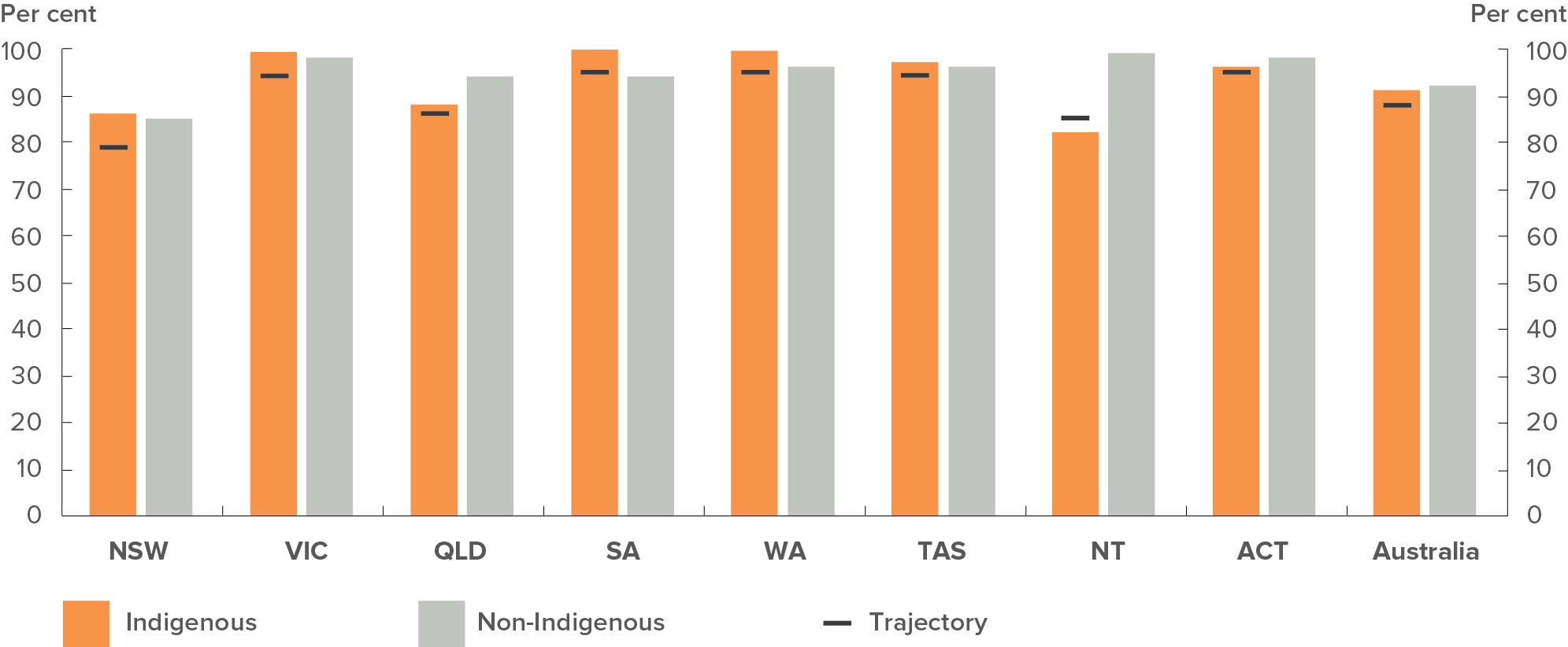
Sources: ABS unpublished, Preschool Education, Australia 2016, Australian Demographic Statistics, June 2016 (Cat. No. 3101.0), Births, Australia, 2016 (Cat. No. 3301.0), Estimates and Projections, Aboriginal and Torres Strait Islander Australians, 2001 to 2026 (Cat. No. 3238.0) and Schools, Australia 2016 (Cat. No. 4221.0).
View the text alternative for Figure 5.
In 2016, of all Indigenous children enrolled in early childhood education, 93 per cent had attended an early childhood education program for at least one hour in the reference week (Figure 6).[16] This was close to the non-Indigenous rate of 96 per cent. All states and territories, except the Northern Territory, had 90 per cent or higher attendance rates, with the highest attendance rates in Tasmania (100 per cent), followed by the Australian Capital Territory (97 per cent) and South Australia (96 per cent).
Figure 6: Preschool attendance by jurisdiction, 2016
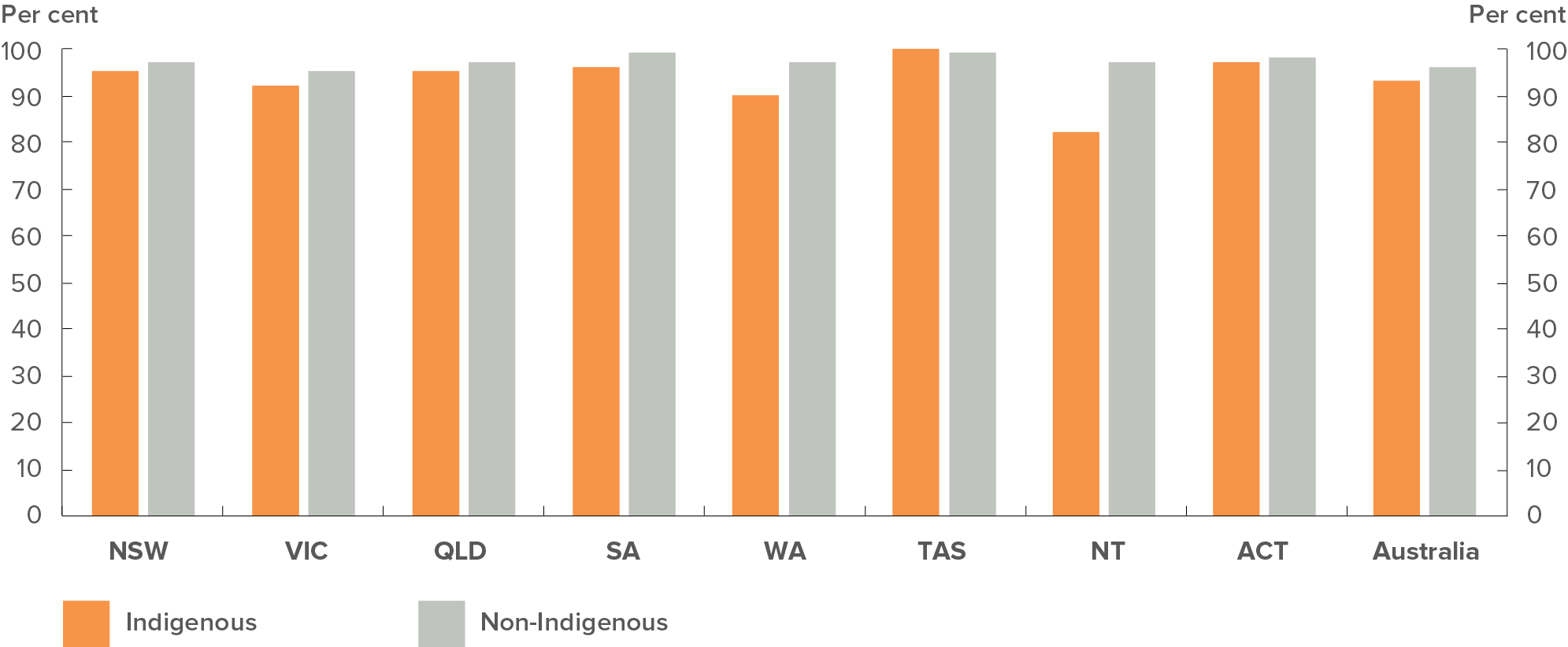
Source: ABS unpublished, Preschool Education, Australia 2016.
View the text alternative for Figure 6.
Remoteness
There are regional variations in the attendance patterns (Figure 7). Almost all (95 per cent) of Indigenous children enrolled in early childhood education attended an early childhood program for at least one hour in the reference week in Major Cities and Regional areas. The proportion of children attending early childhood education programs was generally lower in Very Remote areas particularly for Indigenous children. The gap between Indigenous and non-Indigenous children attending early childhood education programs was largest in Remote (6 percentage points) and Very Remote (11 percentage points) areas.
Figure 7: Preschool attendance by remoteness, 2016
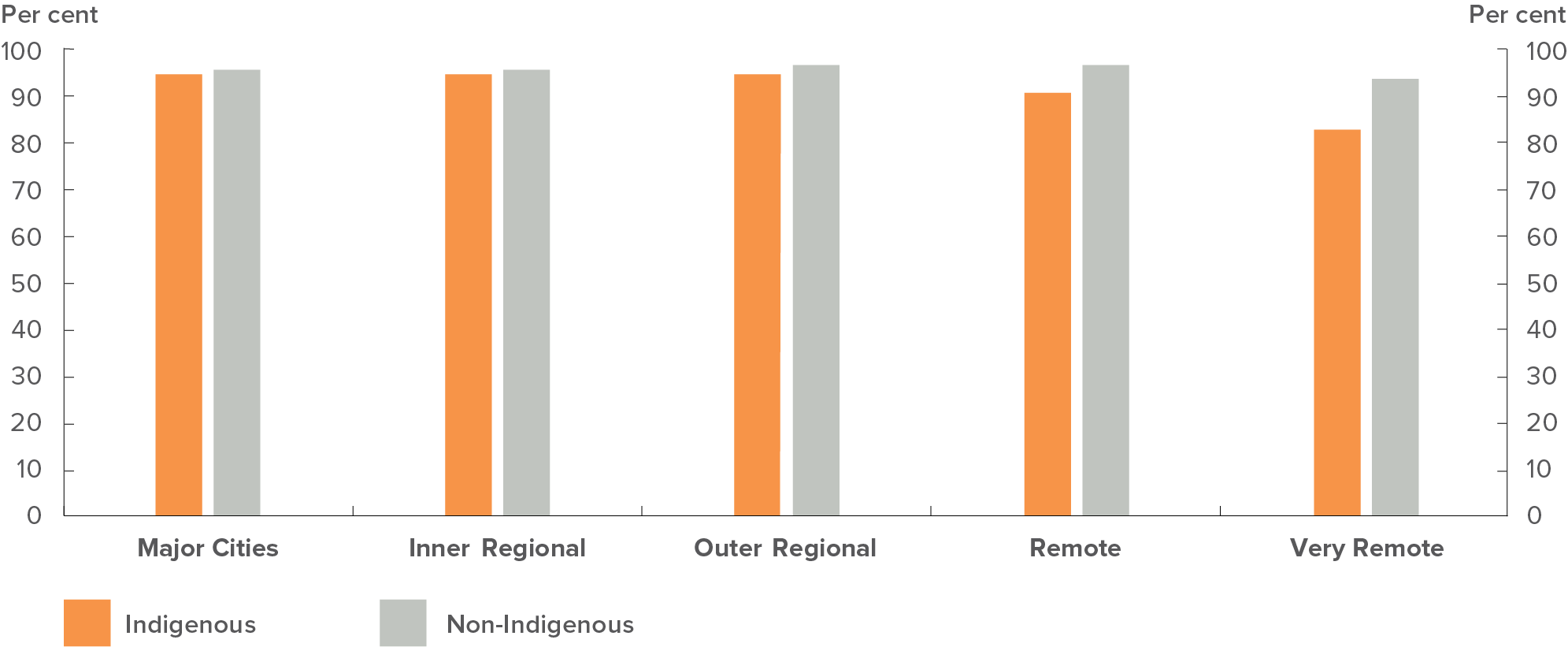
Source: ABS unpublished, Preschool Education, Australia 2016.
View the text alternative for Figure 7.
Hours of attendance represent a key aspect of early childhood education that has a significant direct influence on children’s learning and development and also on children’s overall experience of this stage of education.
The National Partnership Agreement on Universal Access to Early Childhood Education specifies 600 hours per year as the standard for measuring universal access to quality early childhood education programs for all children enrolled in the year before full-time school.
In 2016, most (93 per cent) of the Indigenous children enrolled in an early childhood education program were enrolled for 600 hours or more a year, 70 per cent of these attended for 600 hours or more. This means that 65 per cent of all Indigenous children enrolled in an early childhood education program attended for 600 hours or more (compared to 77 per cent for non-Indigenous children, Figure 8). Queensland had the highest proportion of children attending 600 hours or more (85 per cent), while the Northern Territory had the least (29 per cent).
Figure 8: Preschool enrolments and attendance (600 hours or more a year), 2016
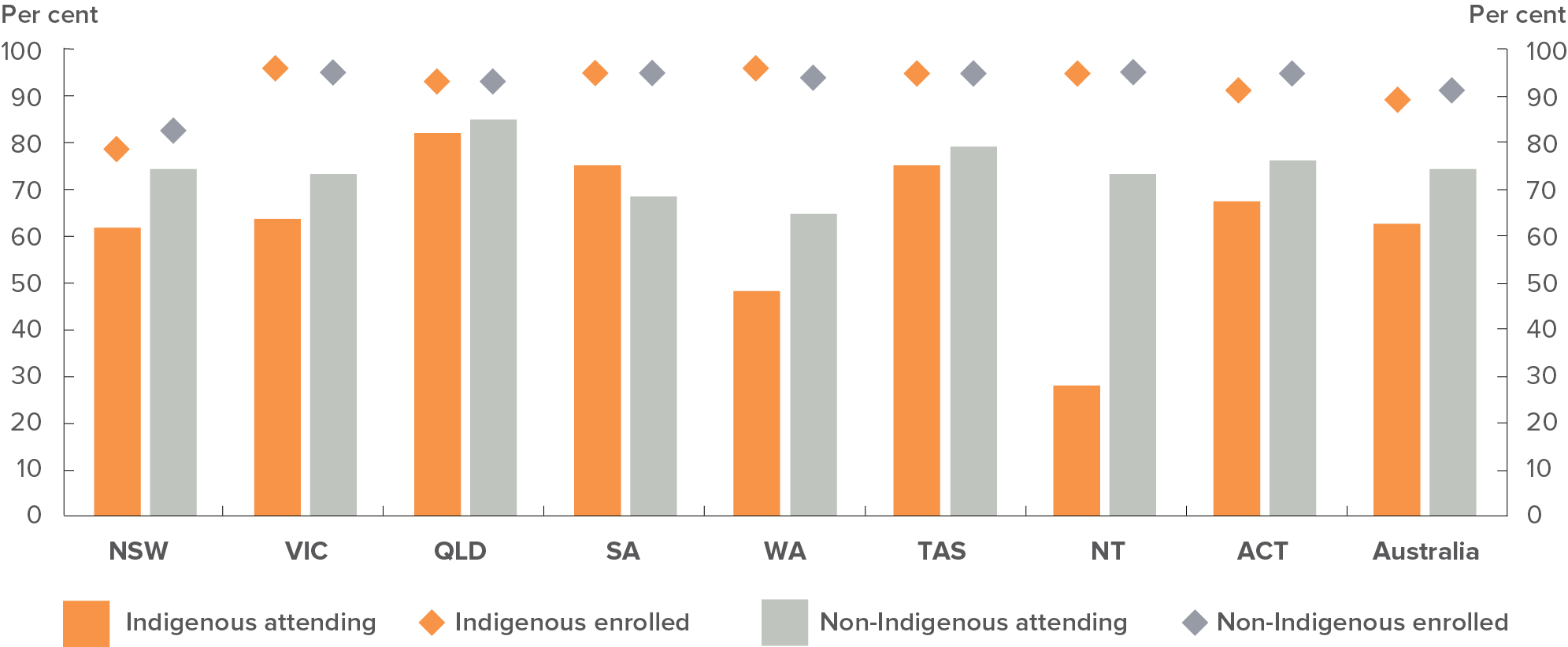
Source: ABS, Preschool Education Australia 2016, Cat. No. 4240.0, 2017.
View the text alternative for Figure 8.
Translating policy into action
Early childhood education
The past 10 years has seen an increased focus and investment in early childhood education and care across Commonwealth, state and territory governments. This recognises that access to quality early childhood services is critical to supporting children’s early development and learning, future schooling and later life opportunities.
Evidence shows engaging in education and care in the years preceding formal schooling can reduce the effects of disadvantage and developmental vulnerability (Box 1: Evidence from literature).
For Aboriginal and Torres Strait Islander children, this is particularly important. Indigenous children are twice as likely to arrive at school developmentally behind as non-Indigenous children. This is due to a range of interconnected and intergenerational circumstances. Although 75 per cent of developmentally vulnerable Aboriginal and Torres Strait Islander children live in regional and urban settings, children in remote locations tend to be more critically vulnerable.
Early childhood education is a collaborative effort across all governments. Under the National Partnership Agreement (NPA) on Universal Access to Early Childhood Education, the Australian Government has provided $3.2 billion since 2008 to states and territories to ensure every Australian child has access to quality early childhood education programs for 15 hours per week in the year before formal school, regardless of the setting. The agreement has a strong focus on participation by Aboriginal and Torres Strait Islander children.
Integrated services have been identified as one of the ways of organising services into systems that effectively support children and families. Coordinated and integrated policies and services help children and their families access a continuum of services and can lead to improved child development outcomes, more children and families receiving services, and better use of financial and human resources.
Early childhood, maternal and child health, and family support services are being integrated with schools in a number of Indigenous communities experiencing disadvantage.
Access to quality childcare provides children with enriched learning outcomes. Since 2003, the Australian Government has funded services under the Budget Based Funded program to support childcare services in regional and remote areas and Indigenous communities. As announced in the 2017-18 Budget, the Government has committed $61.8 million under the Community Child Care Fund to support Budget-based funded services to transition to the new child care package, as well as to support services to meet the costs of expanding to increase Indigenous children’s participation in early education and care.
Families can access fee subsidies from July 2018 and the Child Care Safety Net will provide targeted additional fee assistance to families and supplementary grant funding to services to reduce the barriers in accessing child care, in particular for disadvantaged or vulnerable families and communities.
Across all jurisdictions, there are initiatives in place to improve the cultural competency of early childhood education and care services to increase participation of Aboriginal and Torres Strait Islander children. Evidence suggests that high quality, culturally safe and strong early childhood services act as a protective factor for Aboriginal and Torres Strait Islander children. Under the Indigenous Advancement Strategy, the Government provides funding for activities such as supported playgroups, work to strengthen the cultural competency of preschools, increased engagement with Aboriginal and Torres Strait Islander parents and families, school readiness and employment of Indigenous staff.
Indigenous Early Learning Engagement project
The Indigenous Early Learning Engagement project was established to support the Government’s Closing the Gap target to ensure 95 per cent of all Indigenous four-year-olds would be enrolled in early childhood education by 2025. The project facilitated Start Them Early workshops across Australia, aiming to increase Indigenous children and family participation in quality early learning. In total, 1,180 participants attended 32 workshops throughout Australia.
The workshops connected early learning services with support to increase engagement and cultural competence of services. The project provided a unique opportunity for early childhood providers to learn, firsthand, from Aboriginal and Torres Strait Islander people.
Connected Beginnings
The Australian Government has committed around $10 million per annum from the Community Child Care Fund to the Connected Beginnings program to integrate early childhood, maternal and child health, and family support services with schools in a number of Aboriginal and Torres Strait Islander communities experiencing disadvantage. An additional commitment of $12 million over three years from the Indigenous Australians Health Program will fund health service delivery to enable health services to provide outreach on school grounds, for example by funding a maternal and child health nurse program.
Commonwealth agencies are implementing the program to ensure of Aboriginal and Torres Strait Islander children meet the learning and development milestones necessary for a positive transition to school. The program has commenced in nine sites and will provide children and families with holistic support and timely access to existing services that are co‑located with, or in close proximity to, local schools.
Abecedarian education day care centre
The Commonwealth has also invested in an Abecedarian day care centre in Alice Springs, focused on prevention and cognitive development during early childhood. The centre opened on 20 March 2017 with funding of more than $4 million over two years (2016-17 and 2017-18). The centre focuses on developmentally vulnerable children of non-working parents in Alice Springs and has the capacity to support up to 50 children per day. Based on similar international program outcomes, it is expected the centre will have positive impacts throughout the life course and contribute to participants engaging in education, lessen the likelihood of them smoking or using drugs, and reduce chronic disease and the likelihood of teenage pregnancies.
Indigenous Advancement Strategy
The Australian Government supports activities through the Indigenous Advancement Strategy (IAS) that are designed to support Indigenous families and promote the healthy development of their children. Since the commencement of the IAS in July 2014, the Government has committed $257 million to support early childhood activities. Funded activities under the IAS have a focus on increasing the participation of Indigenous children and parents in early childhood activities, getting children ready for school, developing effective parenting skills and fostering healthy and safe family environments. The IAS funds a range of early childhood initiatives, including supported playgroups, family support services, childcare and supplementary support for preschool.
State and territory initiatives
Early childhood education is a collaborative effort across all governments. States and territories have contributed to developing and implementing a range of initiatives to support Indigenous children and their families.
Local solutions
Headstart Kindy and Preschool helping generations of children
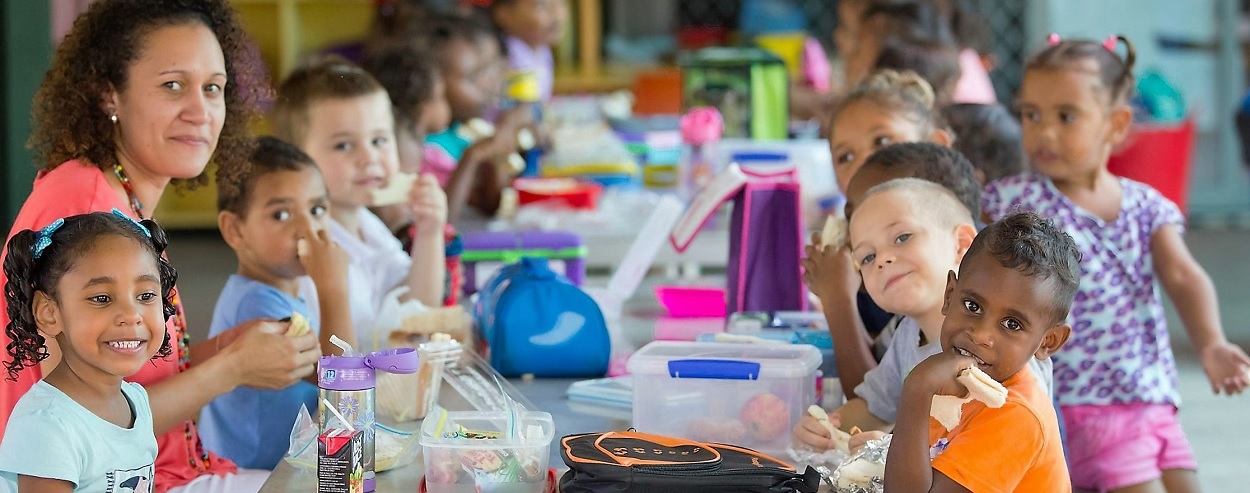
Headstart Kindergarten and Preschool teacher, Danielle Bin Doraho, enjoys lunch with children enrolled at the Townsville learning centre.
Find out more about Headstart Kindy and Preschool helping generations of children.
More local solutions are available on the resources page.
[3] ABS Death Registrations collection is the source for the data. Data are reported for New South Wales, Queensland, Western Australia, South Australia and the Northern Territory only, which are the jurisdictions considered to have adequate levels of Indigenous identification suitable to publish.
[4] From 2015, deaths data provided by the Queensland Registry of Births, Deaths and Marriages includes Medical Certificate of Cause of Death information, resulting in an increase in the number of deaths identified as Aboriginal and Torres Strait Islander in Queensland.
[5] There is a long time-lag between policy and program implementation, and the impact on mortality. In addition, short-term Indigenous mortality data can be quite volatile due to the small numbers involved. For these reasons, long-term data is used to give the fuller picture.
[6] Five years of deaths data are combined for more detailed reporting of Indigenous child mortality to overcome the volatility in rates associated with the small numbers involved.
[7] The perinatal period commences at 20 completed weeks (140 days) of gestation and ends 28 completed days after birth.
[8] Age-standardised data. Trend data excludes New South Wales due to a change in data collection practice introduced in 2011.
[9] Age-standardised data, based on women who gave birth at 32 weeks or more gestation (excluding unknown gestation). Trend data excludes Victoria and Western Australia.
[10] Age-standardised data.
[11] National Early Childhood Education and Care Collection was the outcome of the 2010 National Information Agreement on Early Childhood Education and Care between Commonwealth, State and Territory authorities, and aims to provide nationally consistent and comparable early childhood education data.
[12] Improved data quality in the 2016 NECECC collection, resulting from revisions to the ABS data collection methodology, mean that the 2016 data are not fully comparable to the 2015 data. Significant changes affecting the 2016 data include:
- the ABS has amended its data linkage approach to enhance the accuracy of child counts in NECECC, and
- an expanded child identification strategy in the Child Care Management System (one of the source datasets) has increased the count of children enrolled in a preschool program, as all children at long day care centres (of the appropriate age) are now recorded as enrolled in a preschool program.
For more information on NECECC data quality, including collection methodologies and data limitations, see Australian Bureau of Statistics (2017a).
[13] Estimated population eligible for enrolment in the year before full-time school.
[14] 70 per cent of Indigenous children enrolled for 600 hours or more a year.
[15] Single year of age estimated resident population and population projections may be subject to errors that cannot be adjusted for in the calculation of population estimates. Tasmania and the Australian Capital Territory have relatively small Aboriginal and Torres Strait Islander populations compared to the other states and territories which means year-to-year variability in single year of age populations may be more pronounced. This may result in year-to-year variability of the rate of preschool enrolment in these jurisdictions and should be used with caution.
[16] The census date for the 2016 Collection is Friday 5 August 2016, with the one week reference period spanning 1 August to 7 August 2016. Some jurisdictions may adopt a two week reference period that needs to include the census week which means the permissible period spans 25 July to 14 August 2016 inclusive.

